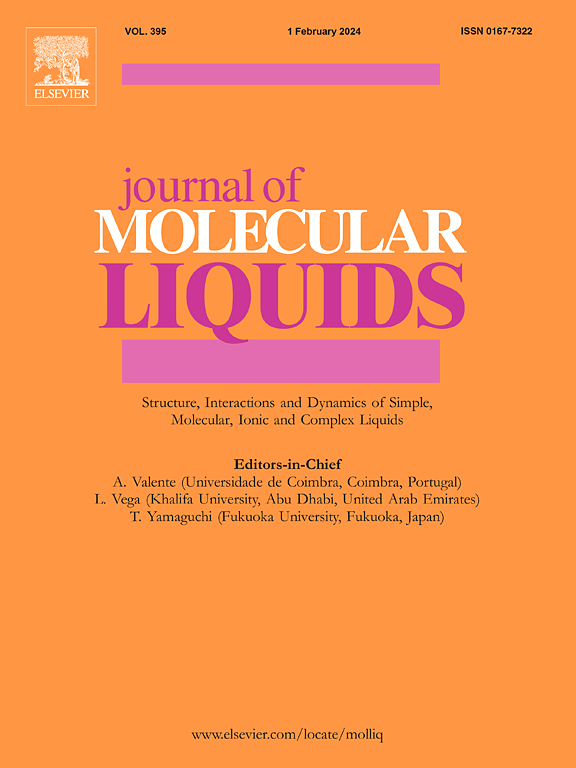Sodium titanate (Na2Ti4O9) nanoribbons for effective removal of organic dyes from water: Experimental and computational studies
IF 5.3
2区 化学
Q2 CHEMISTRY, PHYSICAL
引用次数: 0
Abstract
In this work, Na2Ti4O9 nanoribbons (NTRs) were synthesized using the hydrothermal method for its potential application in water treatment. The NTRs were characterized by X-ray diffraction, field emission scanning electron microscopy, energy dispersive X-ray spectroscopy, transmission electron microscopy, zeta potential, Fourier Transform infrared spectroscopy, and surface area analyzer. The adsorption of organic dyes, including cationic methyl green (MeG) and methylene blue (MB) model pollutants, onto the NTRs was explored for the first time. Various parameters such as pH, adsorbent dose, initial dye concentration, regeneration, contact time, the effect of temperature, and thermodynamics were studied to determine the efficiency of NTRs for removing both dyes from water. A variety of isotherm and kinetic models were applied to fit the dye adsorption data at pH 7.0, providing insights into the adsorption mechanism and process kinetics. Kinetic data for both dyes fit well with pseudo-second-order and mixed 1,2-order models. The isotherm data agreed well with Langmuir-Freundlich and Sips models. At the studied temperatures of 298.2, 318.2, and 328.2 K, the maximum adsorption capacities for MeG (353.2, 367.7, and 443.2 mg·g−1) are significantly higher than for MB (29.3, 52.6, and 67.2 mg·g−1), indicating a stronger affinity for MeG, with adsorption efficiency improving as temperature increases. The MeG samples at 328.2 K exhibited interesting behavior. After adsorption, the samples became colorless, with a final pH near 7.0, indicating effective dye removal. However, the color faintly reappeared at pH 4.0, suggesting pH-dependent behavior and incomplete dye removal. The adsorption mechanism on the NTRs surface was investigated using Monte Carlo and molecular dynamics simulations.
用于有效去除水中有机染料的钛酸钠(Na2Ti4O9)纳米带:实验和计算研究
本研究采用水热法合成了 Na2Ti4O9 纳米带 (NTR),以开发其在水处理中的潜在应用。通过 X 射线衍射、场发射扫描电子显微镜、能量色散 X 射线光谱、透射电子显微镜、ZETA 电位、傅立叶变换红外光谱和表面积分析仪对 NTR 进行了表征。首次探索了 NTRs 对有机染料(包括阳离子甲基绿(MeG)和亚甲基蓝(MB)模型污染物)的吸附。研究了 pH 值、吸附剂剂量、初始染料浓度、再生、接触时间、温度影响和热力学等各种参数,以确定 NTR 从水中去除这两种染料的效率。应用各种等温线和动力学模型来拟合 pH 值为 7.0 的染料吸附数据,从而深入了解吸附机理和过程动力学。两种染料的动力学数据与伪二阶模型和 1、2 阶混合模型拟合良好。等温线数据与 Langmuir-Freundlich 和 Sips 模型十分吻合。在所研究的 298.2、318.2 和 328.2 K 温度下,MeG 的最大吸附容量(353.2、367.7 和 443.2 mg-g-1)明显高于 MB(29.3、52.6 和 67.2 mg-g-1),这表明 MeG 的亲和力更强,吸附效率随着温度的升高而提高。在 328.2 K 下的 MeG 样品表现出有趣的行为。吸附后,样品变为无色,最终 pH 值接近 7.0,表明染料去除效果显著。然而,在 pH 值为 4.0 时,颜色又微弱地恢复了,这表明其行为与 pH 值有关,染料去除不完全。使用蒙特卡罗和分子动力学模拟研究了 NTRs 表面的吸附机理。
本文章由计算机程序翻译,如有差异,请以英文原文为准。
求助全文
约1分钟内获得全文
求助全文
来源期刊

Journal of Molecular Liquids
化学-物理:原子、分子和化学物理
CiteScore
10.30
自引率
16.70%
发文量
2597
审稿时长
78 days
期刊介绍:
The journal includes papers in the following areas:
– Simple organic liquids and mixtures
– Ionic liquids
– Surfactant solutions (including micelles and vesicles) and liquid interfaces
– Colloidal solutions and nanoparticles
– Thermotropic and lyotropic liquid crystals
– Ferrofluids
– Water, aqueous solutions and other hydrogen-bonded liquids
– Lubricants, polymer solutions and melts
– Molten metals and salts
– Phase transitions and critical phenomena in liquids and confined fluids
– Self assembly in complex liquids.– Biomolecules in solution
The emphasis is on the molecular (or microscopic) understanding of particular liquids or liquid systems, especially concerning structure, dynamics and intermolecular forces. The experimental techniques used may include:
– Conventional spectroscopy (mid-IR and far-IR, Raman, NMR, etc.)
– Non-linear optics and time resolved spectroscopy (psec, fsec, asec, ISRS, etc.)
– Light scattering (Rayleigh, Brillouin, PCS, etc.)
– Dielectric relaxation
– X-ray and neutron scattering and diffraction.
Experimental studies, computer simulations (MD or MC) and analytical theory will be considered for publication; papers just reporting experimental results that do not contribute to the understanding of the fundamentals of molecular and ionic liquids will not be accepted. Only papers of a non-routine nature and advancing the field will be considered for publication.
 求助内容:
求助内容: 应助结果提醒方式:
应助结果提醒方式:


